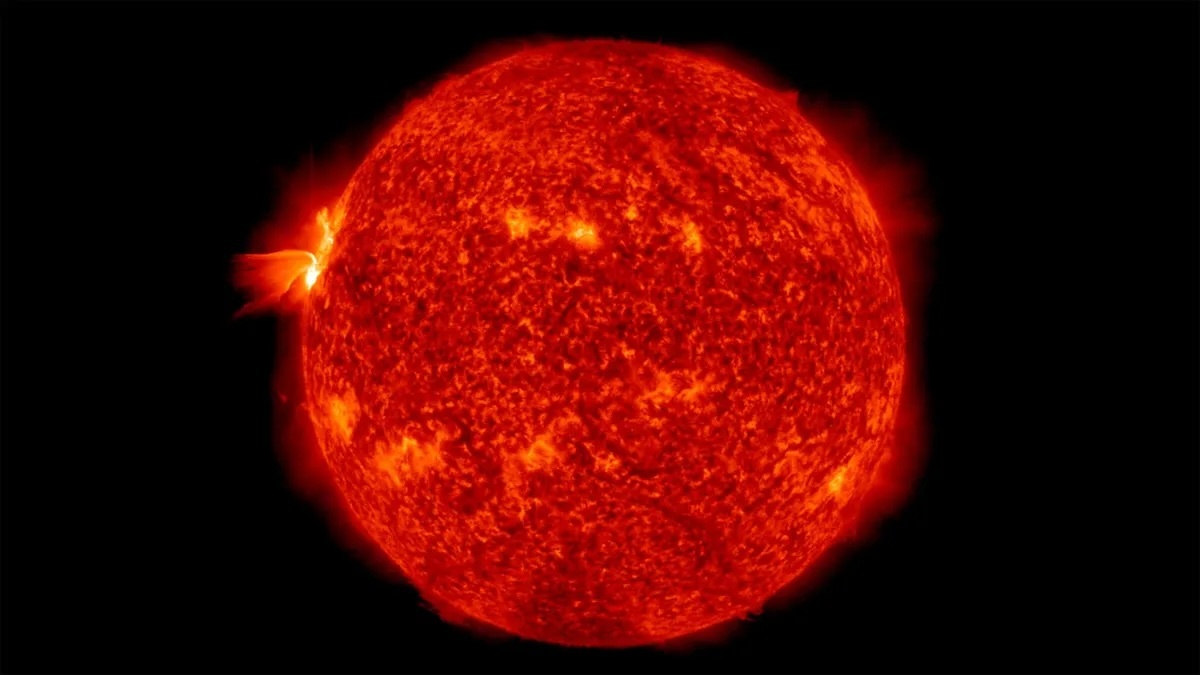8.02.2024
The most comprehensive catalog of slow-building solar flares created since their discovery in the 1980s shows not all solar flares are fast a whip.

A full-disk view of the sun as it unleashed a major X1.1 class solar flare from an active sunspot cluster on April 17, 2022. Not all flares are so rapid and explosive (Image credit: NASA/SDO and the AIA, EVE, and HMI science teams)
New research has created a comprehensive catalog of mysterious, slow-building and ultra-hot explosions coming from the sun's atmosphere. The findings suggest a substantial amount of these strangely lethargic flares, which were first discovered in the 1980s, warrant a deeper investigation.
Solar flares are explosions of energy that occur when the magnetic field lines of the sun tangle, or cross, then snap and reconnect around dark patches called sunspots. These outflows of radiation, when strong enough, can damage satellites and even affect power and communication infrastructure here on Earth.
Solar flares that last for a few minutes to a few hours are traditionally classified based on the amount of energy they emit. This new research, however, differentiated solar flares based on the speed at which their energy actually builds up, showing that many solar flares don't release energy as quickly as the snap of a whip and then slowly dissipate, as the standard picture of these events suggests.
Using the Chandrayaan-2 lunar orbiter, a team of researchers detected 1,400 such slow-rising flares over three years, vastly increasing the slow-flare catalog from the around 100 that had been detected over the last 40 years of solar study.
"There was a consensus in the solar physics community, since the early 2000s, that most solar flares are these rapidly rising intensities, followed by a slow decay," Aravind Bharathi Valluvan, team leader an an astrophysics graduate student at the University of California, San Diego, told Space.com. "However, what my research, along with my team, has shown is that not all solar flares follow that pattern."
Valluvan explained that the solar science community had overlooked slower-rising flares, or "hot thermal" flares because computer algorithms used to detect solar flares in observational data have focused on fast-rising, or "impulsive" flares. Impulsive flares are defined as covering the maximum area they possibly can in under half their lifespan.
"We did not do that, and instead took a more general approach. What we saw is that there are a lot more slow-rising flares, and it's not an insignificant subset. In fact, they form a quarter of all flares," they continued. "So, we need to be studying hot thermal flares as a separate population. Currently, our understanding about these slower type flashes is quite limited."
What makes slow rising flares a mystery?
Slow-rising flares constitute something of a mystery because the magnetic reconnection process believed to generate both impulsive flares and hot thermal flares is rapid, which should give rise to a rapid energy release as well.
Valluvan explained that solar scientists need a better understanding of the precise way slow-rising flares are being generated, how they propagate through the solar corona — the sun's outer atmosphere — and whether this prorogation mechanism may lead to a slower manifestation.
One clue may lie in something that is very counterintuitive about these slower flares: the fact that they are incredibly hot.
Rapid-rising impulse flares are associated with temperatures of around 18 million degrees Fahrenheit (10 million degrees Celsius). But slow-rising flares get their moniker "hot thermal flares" because they are associated with even greater temperatures of up to 54 million degrees Fahrenheit (30 million degrees Celsius).
"One thing certain is that the solar atmosphere is a very violent place. There's a lot of turbulent activity, a lot of fluid plasma magnetic fields mixing out there, so there's a lot of turbulence," Valluvan said. "Impulsive solar flares are associated with nonthermal injection energy process. Turbulent activity causes this nonthermal injection."
Valluvan suggested that it could be a less turbulence-dependent, and more thermal and magnetic process behind the generation of slow-rising flares.
Another significant result of this research is that there are no intermediate flares between fast-rising impulsive flares and slower hot thermal flares. There must be some reason that flares only come in one of two extremes.
"What is this kind of a balancing generation process that is going on?" Valluvan said. "That is something that I've been looking into."
Ultimately, solving the mystery of slow-rising solar flares may help scientists solve a long-standing puzzle: Why is the solar corona hotter than the sun's "surface," or photosphere?
The corona is hundreds of times hotter than the sun's surface despite the fact that the photosphere is closer to the source of the sun's heat, the nuclear fusion processes that occur at its core. This has troubled scientists for around half a century.
"Why is the atmosphere hotter than the surface of the sun? That is something that solar flares have always been hypothesized as a solution for, but we never found evidence for this," Valluvan concluded. "These new types of flashes could be a potential resolution for this coronal heating mystery. And that is one of the things that I am most excited about."
The research is was published in January in the journal Solar Physics.
Quelle: SC

